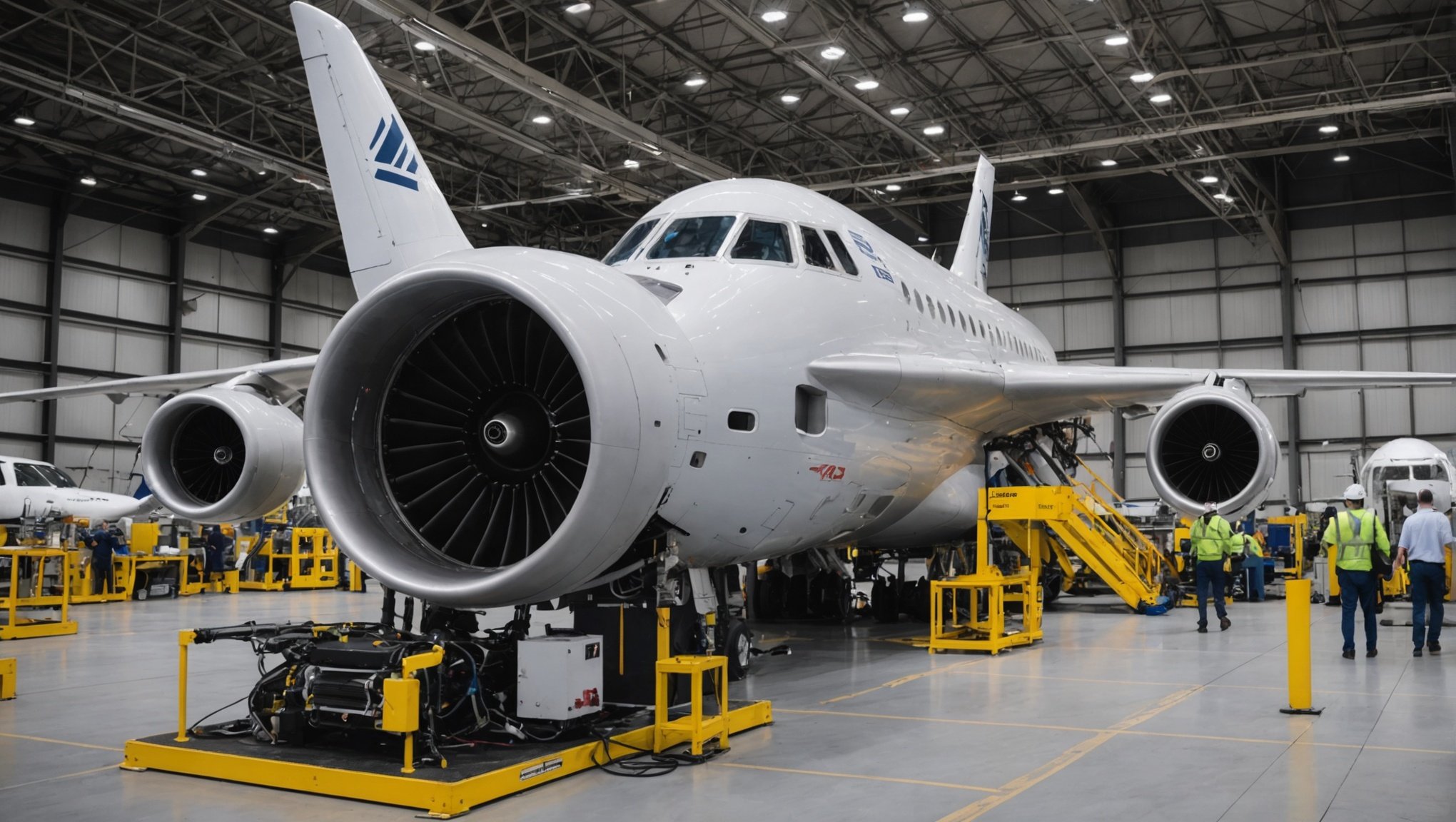Unlocking the Future: Harnessing AI for Superior Predictive Maintenance in Aerospace Engineering
The aerospace industry, known for its complexity and high stakes, is on the cusp of a revolution driven by artificial intelligence (AI) and machine learning (ML). One of the most significant areas where AI is making a profound impact is in predictive maintenance. In this article, we will delve into how AI is transforming the maintenance landscape in aerospace engineering, the challenges and opportunities it presents, and the best practices for its implementation.
The Need for Predictive Maintenance in Aerospace
Predictive maintenance is not just a trend; it is a necessity in the aerospace industry. Traditional maintenance strategies, which often rely on scheduled maintenance or reactive repairs, can lead to significant downtime, increased costs, and compromised safety. Here’s why predictive maintenance is crucial:
Also to read : Revolutionize business expansion using cutting-edge ai workers
- Safety: Predictive maintenance helps in identifying potential failures before they occur, thereby enhancing safety. In an industry where human lives are at stake, this is paramount.
- Efficiency: By minimizing downtime, predictive maintenance optimizes operational efficiency. This is particularly important in air transportation, where delays can have a ripple effect on the entire air traffic management system.
- Cost Savings: Predictive maintenance reduces maintenance costs by addressing issues before they escalate. This proactive approach can save millions in repair costs and extend the lifespan of critical equipment.
How AI and Machine Learning Enable Predictive Maintenance
AI and ML are the backbone of predictive maintenance in aerospace engineering. Here’s how these technologies work:
Data Collection and Analysis
AI systems collect vast amounts of data from various sources, including sensors, historical performance data, and real-time monitoring systems. This data is then analyzed using machine learning algorithms to identify patterns and anomalies that could indicate potential failures.
Also read : Essential Guide to Navigating CCPA Compliance in Your Next Web Application Development
Pattern Detection and Anomaly Identification
Machine learning algorithms are adept at detecting patterns and anomalies in the data. For instance, they can analyze sensor data from aircraft engines to predict when maintenance is needed, reducing the risk of unexpected failures.
Real-Time Insights and Decision Making
AI provides real-time insights that enable immediate decision making. For example, Rolls-Royce uses AI to monitor aircraft engines in real-time, predicting maintenance needs and reducing downtime.
Key Components of an AI-Enabled Predictive Maintenance System
An effective AI-enabled predictive maintenance system in aerospace engineering includes several key components:
Data Collection
- Sensors and IoT devices collect data from various parts of the aircraft.
- Historical performance data is integrated to provide context.
Machine Learning Algorithms
- These algorithms analyze the collected data to identify patterns and predict failures.
- Deep learning models can handle complex data sets and provide accurate predictions.
Visualization Tools
- These tools transform complex data into understandable formats, facilitating informed decision making.
- Real-time dashboards allow operators to monitor equipment health continuously.
Integration with Existing Processes
- Predictive insights are seamlessly integrated into daily maintenance operations.
- Automated workflows ensure that predictive maintenance is part of the standard maintenance routine.
Challenges and Opportunities in Implementing AI for Predictive Maintenance
While AI offers significant benefits, its implementation is not without challenges.
Challenges
- Data Quality and Availability: High-quality and relevant data are essential for accurate predictions. Ensuring data integrity and availability can be a challenge.
- Regulatory and Ethical Considerations: The use of AI in critical industries like aerospace must comply with stringent regulations and ethical guidelines.
- Cybersecurity: AI systems can be vulnerable to cyber threats, which must be mitigated to ensure the safety and security of operations.
Opportunities
- Enhanced Safety: Predictive maintenance significantly enhances safety by preventing unexpected failures.
- Operational Efficiency: AI-driven predictive maintenance optimizes maintenance schedules, reducing downtime and increasing overall operational efficiency.
- Cost Savings: By addressing issues proactively, predictive maintenance can lead to significant cost savings.
Best Practices for Implementing AI in Predictive Maintenance
To maximize the benefits of AI in predictive maintenance, here are some best practices to follow:
Start with a Clear Strategy
- Define clear goals and objectives for the predictive maintenance program.
- Ensure alignment with overall business strategies.
Invest in Quality Data
- Ensure that the data collected is high-quality, relevant, and comprehensive.
- Implement robust data management practices.
Choose the Right Technologies
- Select AI and ML tools that are tailored to the specific needs of the aerospace industry.
- Consider the scalability and flexibility of the solutions.
Foster a Culture of Continuous Improvement
- Encourage a culture where predictive maintenance is seen as a continuous improvement process.
- Regularly update and refine the AI models based on new data and insights.
Real-World Examples of AI in Predictive Maintenance
Several companies in the aerospace industry are already leveraging AI for predictive maintenance with remarkable results.
Rolls-Royce’s Intelligent Engines
Rolls-Royce uses AI to monitor aircraft engines in real-time, predicting maintenance needs and reducing downtime. This approach has significantly improved safety and operational efficiency.
IAG’s Predictive Maintenance Initiatives
International Airlines Group (IAG) is investing heavily in AI for predictive maintenance, route optimization, and personalized marketing. Their initiatives aim to streamline operations, predict customer needs, and increase efficiencies across the board.
The Future of Predictive Maintenance in Aerospace
As AI technologies continue to evolve, the future of predictive maintenance in aerospace looks promising.
Integration with Other Technologies
- AI will be integrated with other emerging technologies like blockchain and the Internet of Things (IoT) to create more robust and secure systems.
- The use of renewable energy sources will become more prevalent, driven by AI-optimized energy management systems.
Advanced Materials and Design
- AI will play a crucial role in the development of advanced materials and generative design, leading to lighter, stronger, and more fuel-efficient aircraft.
Air Traffic Management
- AI will be used to optimize air traffic management, reducing congestion and improving the overall efficiency of air transportation systems.
The integration of AI in predictive maintenance is transforming the aerospace industry in profound ways. By leveraging data-driven insights, machine learning algorithms, and real-time analytics, companies can enhance safety, improve operational efficiency, and reduce costs.
As Dr. Ben Dias, IAG’s Chief AI Scientist, notes, “AI has the potential to make our businesses perform better, help our employees, and is essential to our long-term success.” The future of aerospace engineering is indeed shaped by AI, and embracing this technology is crucial for staying ahead in this competitive and rapidly evolving industry.
Table: Comparing Traditional and AI-Enabled Predictive Maintenance
| Aspect | Traditional Maintenance | AI-Enabled Predictive Maintenance |
|---|---|---|
| Data Collection | Limited to manual logs and scheduled checks | Real-time data from sensors and IoT devices |
| Analysis | Human analysts review data periodically | Machine learning algorithms analyze data continuously |
| Prediction | Reactive approach based on historical data | Proactive approach using real-time data and ML models |
| Downtime | Significant downtime due to unexpected failures | Minimal downtime with predictive maintenance |
| Cost | Higher costs due to reactive repairs | Lower costs with proactive maintenance |
| Safety | Higher risk of unexpected failures | Enhanced safety with predictive maintenance |
| Efficiency | Lower operational efficiency | Higher operational efficiency |
List: Key Benefits of AI in Predictive Maintenance
- Enhanced Safety: Predictive maintenance reduces the risk of unexpected failures, enhancing overall safety.
- Operational Efficiency: AI optimizes maintenance schedules, reducing downtime and increasing operational efficiency.
- Cost Savings: Proactive maintenance reduces repair costs and extends the lifespan of equipment.
- Real-Time Insights: AI provides real-time data analysis, enabling immediate decision making.
- Improved Decision Making: AI-driven insights facilitate better decision making, reducing human error.
- Scalability: AI solutions can be scaled to meet the needs of large and complex aerospace operations.
- Integration with Existing Systems: AI can be seamlessly integrated with existing maintenance processes, enhancing overall efficiency.
By harnessing the power of AI, the aerospace industry can unlock a future of superior predictive maintenance, marked by enhanced safety, improved efficiency, and significant cost savings. As we move forward, it is clear that AI will be a crucial component in shaping the future of aerospace engineering.











